Caja Drum – Everything You Need to Know
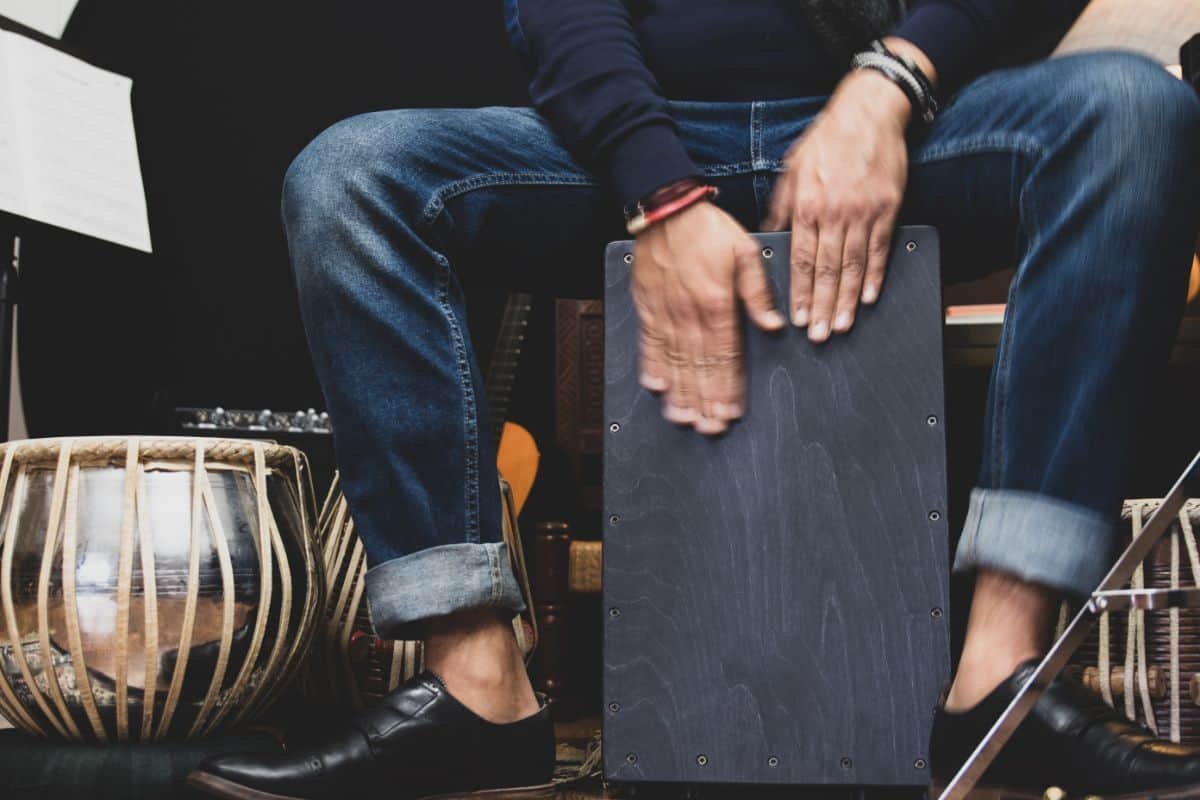
Cajon is an extremely simple in design, yet incredibly versatile instrument. Used by everyone from flamenco musicians to studio performers and buskers, this Caja drum is popular worldwide. It has a rich history that begins in the African drumming traditions and finds its way into contemporary music. Cajon creates a rich earthy sound that creates perfect accompaniment for singers and guitarists. Caja drum also has a simple design and is very easy to transport, with the extra perk of being its own sitting place. All this makes it one of the most popular musical instruments in the world.
A Full Guide to a Caja Drum
Contents
Caja drum is incredibly simple in design and use but has the benefit of many variations and subtypes which all have different unique sound profiles. From the snare Cajon which could substitute an entire drum set, to the use of the Caja drum as a base drum. Let’s look at what exactly a Cajon is, its history, and what you should know about it.
What is a Cajon?
What is a Cajon? The word Cajon or Caja comes from Spanish and translates as box or drawer. This is quite literally what a Caja instrument is: a six-sided wooden box with a sound hole cut on the backside of the box. In a traditional Cajon five sides are made of wood, while the sixth one is made of thinner bendable material like plywood. That is the striking side of the Cajon, called tapa. The box can vary in size: traditional Cajon can be 18 inches tall and 12 inches wide, while some models are significantly bigger.
Modern Cajon also has rubber feet and several screws at the top which allow you to adjust the timbre.
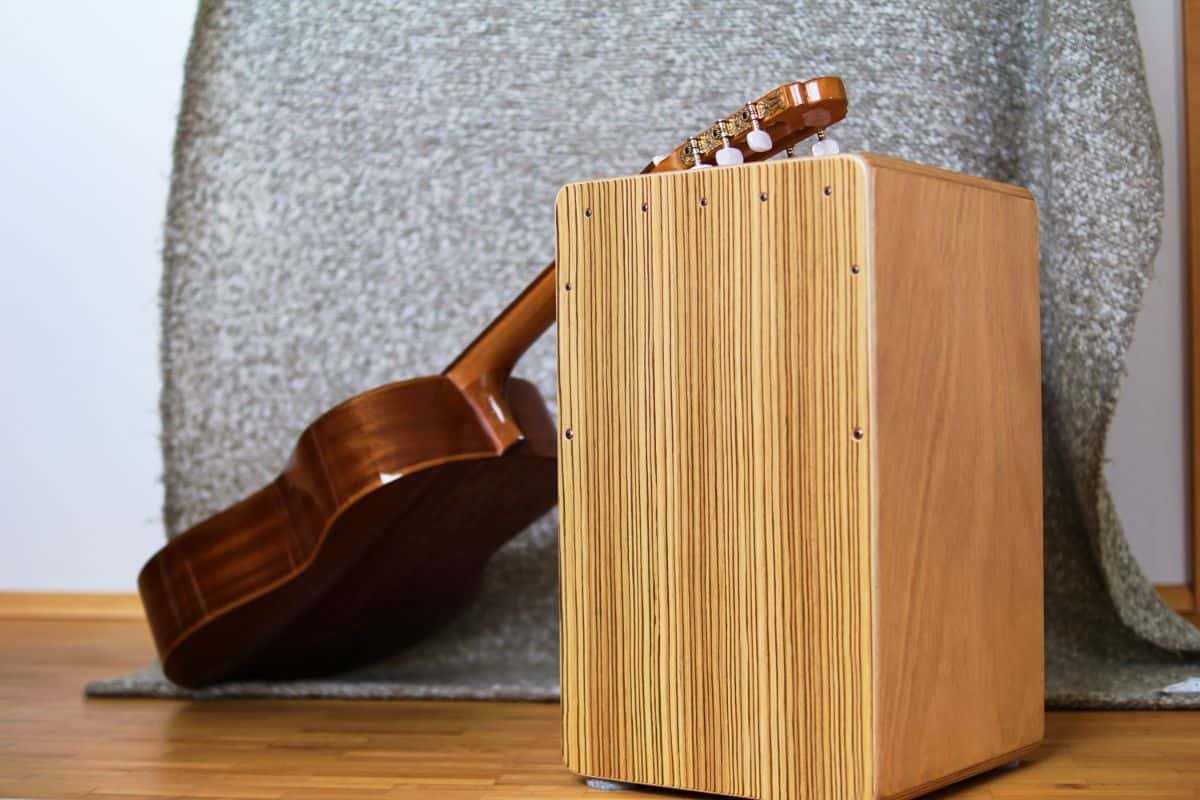
Cajon is a 3-in-1 instrument, a stand, and a sitting place. The Caja drum is played by sitting on it and hitting the striking side, which produces different types of sound depending on where you strike. Closer to the edge, the Cajon produces a higher pitch sharp sound, similar to a basic snare in a traditional drum set.
Closer to the middle Cajon makes a low-pitched sound, close to traditional bass drums or toms.
Different techniques (scrape, pluck, mute) on the Caja drum allows you to have an even wider range of sound, as well as modifications such as bending the plywood with your foot or adding strings inside for resonance.
The size and weight of the Cajon make it a wonderful instrument to travel and perform spontaneously. It’s beloved by buskers and street musicians all over the world. Performing in a group with several Caja drums can be an amazing experience too, allowing you to experiment with rhythm and pitch.
Where did Cajon come from?
The history of the Caja drum starts in West Africa, where many tribes had a rich and extensive drum and percussion traditions, using many drumming instruments like a djembe and dun. When African people were captured and enslaved, they still carried their rich tradition of drumming with them but weren’t able to make or craft any instrument. In the 18th century, Peru slave owners made it illegal to play traditional African drum music. The legislation was imposed by the Colonial Spanish government, who thought that musical gatherings had the potential to become meetings for unrest and rebellion.
Cajon was born out of necessity. Not only did the slaves have plenty of shipping boxes and drawers, which could be easily accessed, but their shape and look made them look inconspicuous – at any time they could just sit down on this box, which worked as a makeshift chair. The first Caja instrument could’ve been a simple fruit crate, and the dual purpose of acting as a musical instrument and a chair still is one of the reasons it’s so popular even now.
The early Caja drum was made of wood and had 5 thick sides, and one more flexible thinner striking side called tapa. A soundhole was made on the backside of the Cajon to let the sound escape.
Throughout the 18th century, the Cajon instrument spread from Peru to Cuba and from there to America. Drummers began experimenting with Cajon, changing the design and creating different shapes and sizes which changed the sound patterns and vibration. Early modifications simply bent the planks to change the sound, but later modifications had the addition of strings as well as varying sizes.
Cajon and the music performed on it developed along with the Peruvian-African culture, and the Caja drum was widely used to make dance music for new dances like festejo and zamacueca.
A person credited for bringing Cajon to European audiences is a Spanish virtuoso flamenco guitarist Paco de Lucia. While performing in Lima in the 1970s with Peruvean percussionist Caitro Soto he discovered the Cajon for himself and brought it back with him to Spain. He recognized that the Caja drum could be used for flamenco music, solving the need for percussion. Soon Cajon became a staple in contemporary flamenco as well as genres like folk, jazz, blues, and rock.
What parts Caja drum consists of?
In the simplest form, a Peruvean Cajon is a 6-sided box, with a striking side made of plywood (designated front side) and a soundhole opposite of it (designated backside). The modern Caja drum also has rubber legs.
The relative simplicity of the Cajon instrument makes it easy to make yourself, and plenty of people do so, experimenting with construction, materials, sizes, and various additions to it.
When Paco de Lucia brought the Cajon with him to Spain he modified the instrument by adding guitar strings to the rear of the tapa. This gave the Cajon instrument a snare-like rattle. It helped the beat to cut through other instruments used for flamenco music. The result was Flamenco Cajon which gradually became a snare Cajon – an immensely popular variation of the Caja drum.
Caja vallenata is another version of the Caja drum. It gets its name from Vallenato music – a popular folk music genre from Colombia. Though it translates similarly to a ‘box’ or a ‘drawer’, Caja vallenata resembles a bucket or a small barrel. This drum is an elliptic cylinder made out of wood with a cow skin drumhead stretched over the top opening. The modern version is more similar to conga drums, though shorter in height (approximately 12 inches). In the way it is played it has more in common with the Tambora’s. Unlike a Peruvean Cajon, Caja vallenata is played by placing it between your knees and striking the drumhead with your hands. Because the modern version has a metal frame that is bolted to the skin drumhead, it functions as a snare drum but is only played with bare hands.

Do all Cajons have snares?
What is inside a Cajon instrument largely depends on what type of music it’s meant to play and what are the preferences of the Cajon maker. Traditional Peruvean Cajons consist only of a wooden box and they don’t have any snares in them.
Paco de Lucia is largely credited with adding strings to the flamenco Cajon. Today lots of caja drums have snares, small bells, microphones, or bass enhancing foam.
Cajon that has a snare wire system produces a rattling buzzing sound when the tapa is hit. Those are the same tightly curled wires you can find in a traditional snare drum. These snares can be adjusted and muted while the player is seated, and are customizable and can be removed or fixed.
While the snare Cajon is the most recent type of the Caja drum, almost 90% of the available Cajons are of this type. Most of the popular types of Caja drums offer a snare system attached in such a way that you achieve full separation of the snare, fixed in the upper register of the Cajon, with the bass tone.
While snare Cajon is the most popular commercially sold form of Cajon, it is still possible to get modifications that allow you to mute or tone down your snare if you want to.
Can you use drumsticks on a Cajon?
When it comes to modern Cajon, their performance styles and accessories that can be used to play it are endless.
Drumsticks are often used to play the Caja drum. They look like the ones that can be used on a regular kit, but there are also drumsticks finished with rubber tubing to lower the intensity of the beats since Cajon has a lower pitch than the regular drums.
Cajon drum sticks are used in the exact same way the regular drumsticks are but can be combined with hands and brushes to achieve various sound effects.
What other accessories can be used with Cajon?
Cajon accessories have been developed in a similar way to the various Caja drum modifications: people have experimented with tools in order to achieve the desired sound. And because Cajon is so adaptable and versatile, plenty of tools and techniques can be applied to it.
Cajon Brushes are used to create unique sounds during a performance. The polymer strands hit the tapa and produce an exciting sound. Using a brush is relatively easy if you already know how to use the drumstick. Additionally, the polymer strands of the brushes can be adjusted with a special ring. A louder and deeper sound of Cajon can be produced if you move the rings towards the tip of the brush, and vice versa, a much more subtle light sound is produced when the ring is at the handle of the brush.
The Cajon pedal makes an amazing bass effect on the Caja drum. The external pedal is controlled by the foot and can be adjusted to strike the desired place and produce the sound you want.
The Cajon pedal is often used in genres like rock, pop, etc. because of the flexibility it gives, which, perhaps, cannot be attained by only playing with your hands. You should start off with finding the position that you want the drumstick to hit and after that, it’s easy to start experimenting with the rhythm.
Cajon mic processor. While the Cajon itself produces an acoustic sound, there are many models that combine the electrical parts and include mic enhancers and processors. They are especially useful when you’re composing music on a Caja instrument. Mic processors can record the acoustic sound that you play on your Cajon, and adjust the sound, quality, pitch, and any other settings that your mic offers.
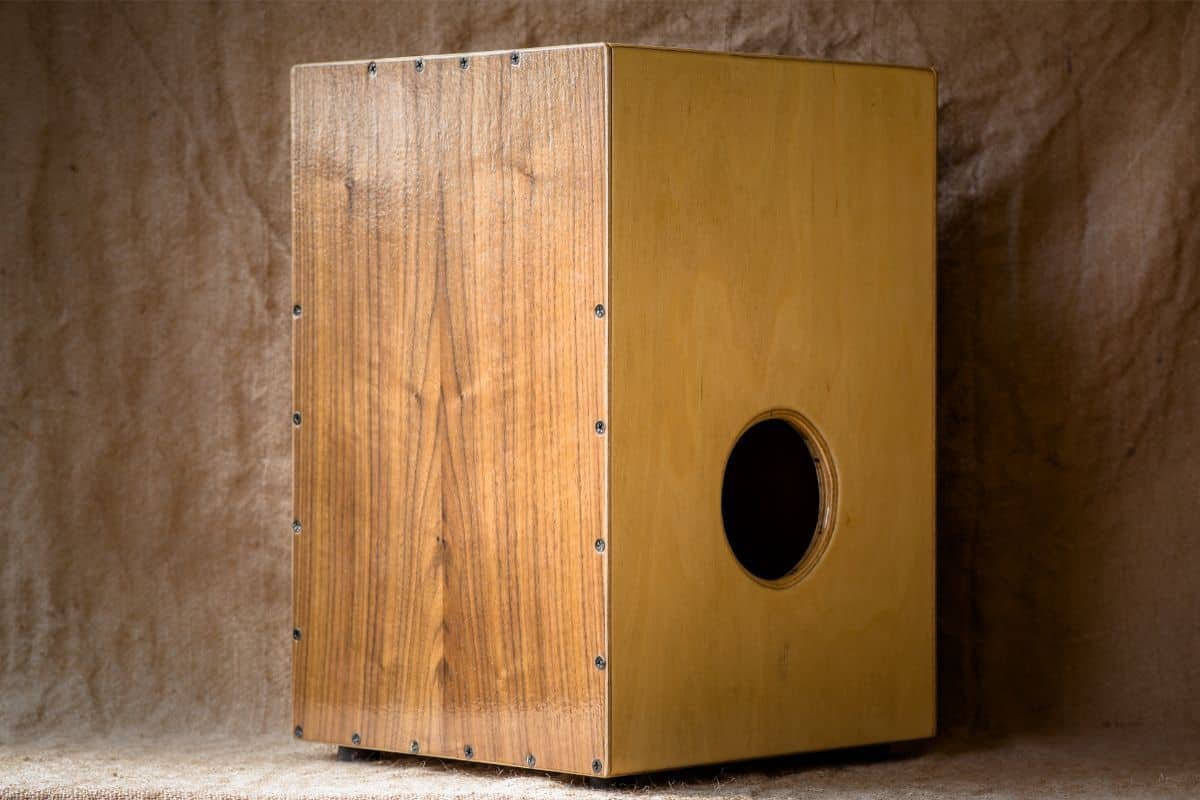
Is Cajon easier than drums?
As with any percussion, it’s quite difficult to compare the instruments in terms of how interchangeable they are. Cajon is a flexible instrument that many beginners gravitate towards because of its simplicity in both design and transport. A full drum kit, as epic and amazing as it is, is not easy to learn for beginners and is not at all easy to transport and purchase.
The technique, however, is different from that of the full drum set. So while Cajon can be easier to learn for beginners, you shouldn’t think of it as a ‘training kit’ for a full drum set.
Cajon instrument has the unique ability to provide you with two tones, and with the addition of many accessories like pedals, snares, and drums, the Cajon is able to replicate lots of the same sounds that a drum set does.
Many drummers who have already learned the basics or even became quite good on the drum set find the Cajon incredibly appealing because of its versatility. Unlike a traditional drum, the Caja drum has two basic sounds. Figuring out how the technique you’ve gotten used to on separate toms and cymbals into a rhythm on a Cajon is a very intuitive, yet fascinating process. It also produces a wide variety of sound and rhythmic patterns, so it is very useful for those who are looking for an instrument like this for the band.
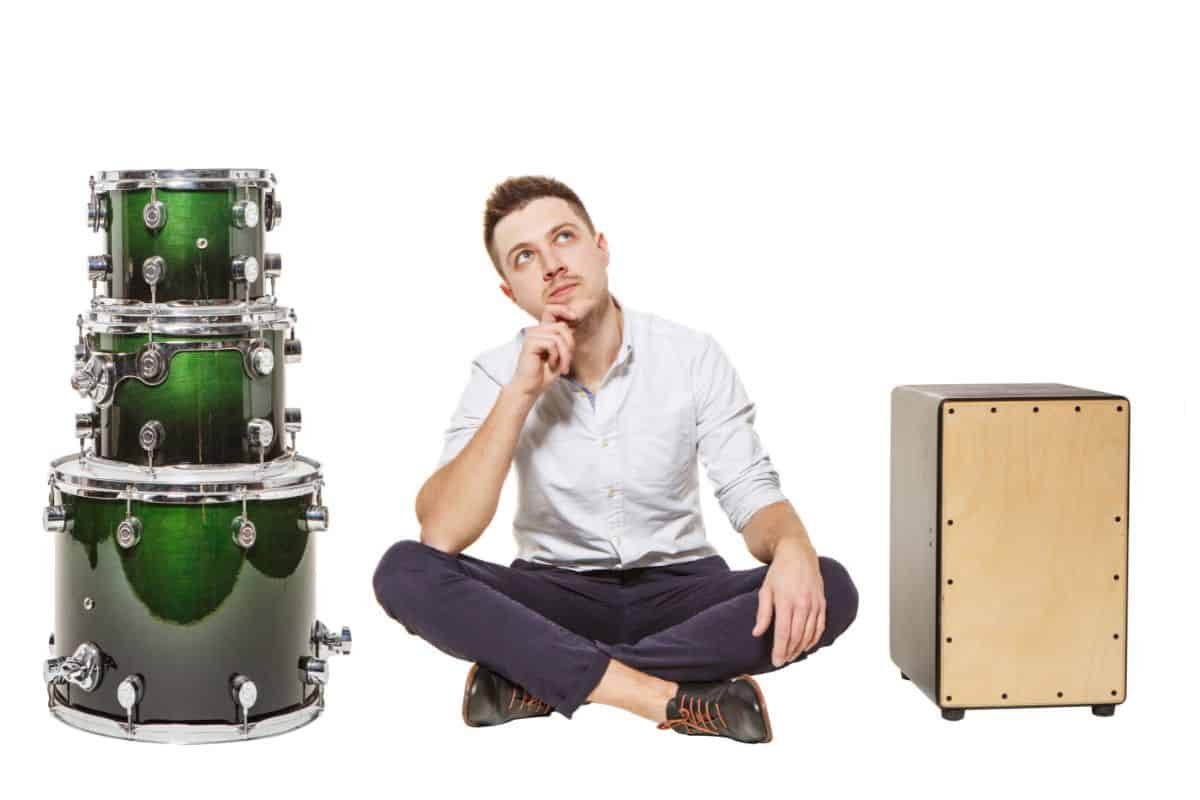
How do you play a Cajon instrument?
Cajon is traditionally played by sitting on top of it and hitting the tapa with your hands.
When learning how to play a Caja drum it’s important to keep several points in mind:
- Health and safety: because you sit bending down, it’s important to stretch properly before performing and throughout the performance
- Posture: keeping your back straight rather than hunched is important. You should also try to avoid tension as much as possible.
- Personalize: while traditionally you have to sit atop your Cajon, many players choose to sit behind it on a chair, or to tilt it inward as they play. Figuring out which way works best for you is part of the process since the Caja drum is really open to different styles.
Because a Cajon functions as a sitting place too, there are several things you should keep in mind while choosing a Cajon.
If you’re really tall, playing a Caja drum can be quite difficult, so unless you’re making a Cajon for yourself you might want to look into buying an adapter for the Cajon instrument. It can help you change the height and the sitting area of the instrument without compromising on the sound. This is also a good option if you experience lower back pain.
Another frequently asked question is how much weight can a Cajon hold? The question is quite simple – as much as the regular stool. A standard office chair can hold up to 250 pounds. Different wood also has different strength properties, as well as sizes.
At the end of the day, when choosing a Cajon you should make sure it’s comfortable for you to sit on.
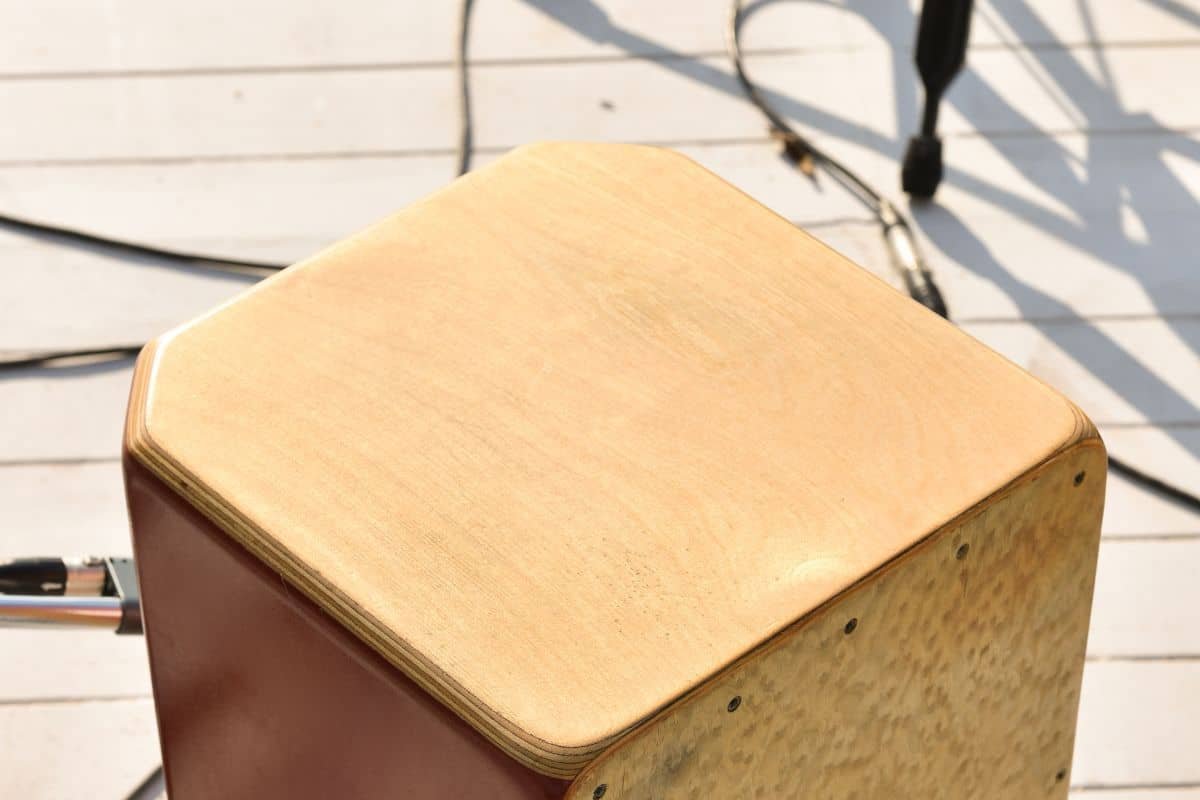
What maintenance and storage does a Cajon require?
As with any instrument, there are Cajon cases and bags designed to protect your instrument. One of the main advantages of a Caja drum is the easy transportation and relatively low weight. However, if you play lots of gigs, choosing a properly padded gig bag for your Cajon will go a long way to ensure your instrument is in a top condition.
On top of that, there are several Cajon pads, seats, and cushions, meant to ensure your comfort. Lots of gig bags have extra pockets, where it’s easy to store drumsticks, brushes, and other equipment.
Professional cleaning and maintenance kits can help you properly take care of your Caja drum: there are brushes and polishes that remove dust and dirt that might compromise the sound quality of your Cajon.
The incredible appeal of Cajon
The Caja drum is an incredible rhythmical instrument, that is not only simple in its build and use, but also solves many problems that percussion instruments have: the need for a big kit in order to produce sound, the difficult transportation, and the need for long training. Cajon is not heavy, is easily transported, acts as its own sitting place, and has plenty of customizable features that can fit the type of sound you play. They’re also easier to learn for beginners and are incredibly rewarding for those who already can play a professional drum set.
Would you like to try to play a Cajon? Do you already own one? Write about your experience in the comments down below!

